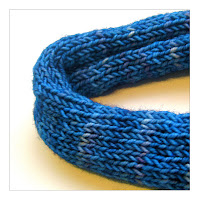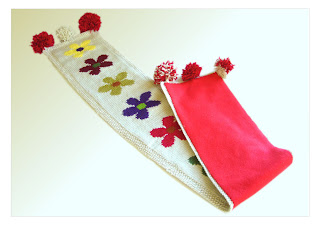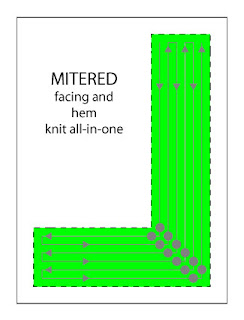Here is the problem, a curling stockinette scarf made of blue and purple sparkly yarn.
Today's post shows a method called the drop-column method, which cured the stockinette roll and made this scarf lie flat. The drop-column method could hardly be easier. Every fourth stitch, a column of stitches is dropped down the scarf length to create a ladder. Then, the scarf is steam blocked. Once blocked, the drop-column fabric goes from wildly curly to flat. Here is a picture of the front and the back of the same scarf, after the drop-column method has been applied.
 |
| Front and back |
Despite how easy the drop-column method is, I almost didn't include it in this series for five reasons.
- It really was designed for WOOL. If you try this method on any fabric except wool, you take the chance of RUINING YOUR SCARF, yes, maybe R.U.I.N.I.N.G. it FOREVER. You have been warned--the drop column method is for wool alone!
- The finished look is quite lacy, not a look suitable for all situations.
- The technique is rather primitive
- The resulting fabric is delicate--it snags easily, for example
- When the time comes to wash it, a drop-column scarf needs to be handled with the UTMOST care: hyper-gentle hand washing, laid flat to dry, NEVER, EVER in the washing machine.
Yet, despite these objections, in the end I decided to give this method its own post because it has three indisputable things going for it.
- IN WOOL, it really, really works.
- It is really, really easy.
- It is really, really fast.
Bottom line: if you want to cure the roll on a WOOLEN scarf knit in stockinette, if you would wear a lacy scarf and if you are willing to care for a delicate fabric, let's take a look at the drop-column technique of curing stockinette roll. (If this is not your situation, remember, there are two more posts to come in this series!)
MY SCARF IS ALREADY CAST OFF--CAN I RE-WORK IT NOW?
Are you surprised to see a method using live stitches recommended for restyling an already-finished scarf? Way back in 2006,
in the second TECHknitting post ever, knitting's inner nature was discussed. That post stated that any single knit stitch maintains its connection with all the other stitches in its row and its column, even after the knitting process is complete.
In practical terms, this means that knitting can be restyled even years after it first comes off the needles. In even more practical terms, this means that yes, you can put the stitches of an already-knit scarf back on the needles and re-work the fabric, transforming curly rolled-up stockinette into a non-rolling drop-column fabric. Here's how.
CATCH THE LIVE STITCHES at the
TOP and BOTTOM of the SCARF on
KNITTING NEEDLES
Restyling knitting is actually fairly common. For example,
re-working the length of a garment (making it shorter or longer) has already been dealt with in an illustrated post. The first step in length-restyling is the same as in fabric-restyling: getting the stitches back on the needles.
Basically, there are two methods. First, you can carefully unpick the original bind-off, catching each live stitch on a knitting needle as the bind-off is released. Alternatively, you can carefully snip a single stitch in the middle of the bottom row, then unravel in both directions from the middle, again catching the stitches on a knitting needle as they pop loose.
Click over to the length post for further details and an illustrated how to. You only need to follow along in that post until you get the stitches situated correctly, right arm forward (third illustration, step 6). After you've gotten that far along, come on back to this post!
For the drop-column method, not only is the bind-off undone, but the cast-on is also undone. Again, this can be unpicked or snipped, and again, the length post has illustrated details (removing the cast-on is the same process as removing the bind off.) After you have the top and bottom of the scarf on knitting needles, it will look like the illustration below.
MAKE SURE YOU HAVE ENOUGH YARN TO USE IN YOUR BIND OFF
In the illustration above, note the mini-skein of yarn at both ends of the scarf. If you don't have any excess yarn from the scarf in your stash, then when you put the live stitches on your needles, you must unravel an additional two rows, in order to have enough yarn to bind off the top and bottom when the restyling is complete.The model scarf used up all the yarn, so the mini-skeins represent the top and bottom two rows which were unraveled and are being held in reserve for the bind-off.
DIRECTION OF DROP
Usually, ladders are dropped in stockinette top-to-bottom, rather than bottom-to-top. If you are having a hard time telling which is which, you will see that there is an odd sort of half-stitch at the very edge of the bottom, which is absent at the top. In the illustration below, the half stitch is shown--it is the little extra purple stitch peering around the left side of the "real" blue edge stitch.
However, if you can't tell top from bottom, it really isn't all that important: Stockinette is essentially reversible, being only one-half column off between top-to-bottom and bottom-to-top
(which is why, just like when you unzip a provisional cast on, you may find that you get one less stitch working "up" (top needle) than working "down" (bottom needle) . Whichever way you run out the column of stitches, though, you will get a ladder.
SPACING THE COLUMNS TO DROP
The edge three columns are not worked in any way--we leave them alone to avoid stirring up tension issues at the side edges of the scarf. Across the rest of the scarf, the idea is to drop every fourth stitch (3 stitches undropped, followed by a ladder). If your stitch count will not fit evenly into these constraints, not to worry--the excess stitches are hidden between the edges of the scarf and the first dropped column on each side. The edge flips over 180 degrees at the first dropped column, perfectly hiding any excess stitches.
If math is not your strong point, you can click through to
this chart which shows where to slip stitches and where to drop them in order to distribute the columns as evenly as possible for all stitch counts between 15 and 50.
The illustrations below shows the chosen stitches dropped off the holding needle and run down three stitches. The left picture is unstretched, the right, stretched.
At the bottom of each dropped column, stop the ladder two stitches from the bottom, and catch the loose stitch on a safety pin or stitch holder. You don't want to get any closer than two stitches or you run the risk of making a hard-to-fix loopy mess.
BIND OFF the SCARF BOTTOM
When you have run out all the columns, take a free knitting needle in your right hand, and the holder needle with the bottom stitches in your left hand, then bind off the bottom of the scarf--
the chain bind off is very good for this situation. As you come to the loose stitch at each column-bottom sitting on its holder, undo the holder and place the held stitch on the tip of your left needle, then bind it off together with its left-hand partner, two stitches bound off as one.
BIND OFF the SCARF TOP
The next step is to bind off the top. Bind off the ordinary stitches in the usual manner. When you come to the top of each ladder, grab it with your fingers and twist it into a backwards loop, then place the loop on the left needle. This twisting maneuver transforms each ladder's top rung back into a stitch capable of being bound off. Bind off all the top stitches including the twisted loops. Again,
chain bind off is a good choice.
STEAM BLOCK the SCARF
The last step of all is to
steam block the scarf. Below are before and after photos of the fabric--the before represents the look of the fabric when the columns have been run out, but not yet steam-blocked, the after shows how the scrunched-up ladder rungs blossom open from the blocking process.
 |
| The ladder rungs, before and after steam blocking |
To get from "before" to "after," as you make each section of the scarf steamy with the iron, spread it apart with your hands by gently patting it wider. When the steam dries away, the rungs will remain in the relaxed, open position shown in the after photo.
WHAT WILL MY SCARF LOOK LIKE?
The sparkly blue sample scarf corrected in this post came out quite loose and lacy. This is partly because it was knit loosely, partly because the yarn was of a nature to easily relax during the steam-blocking process. Pictured below is a different drop-column scarf, this one in red, which came out a bit differently.
If you compare the blue to the red, you'll see that the red scarf was knit tighter, and its yarn did not relax as much from the steam-blocking. As a consequence, the red scarf's ladders are narrower and the fabric came out more wavy (bumpy) in cross section. However, the stockinette curl has been cured on both scarves by the drop-column method, and both have been transformed from tight unwearable tubes into (delicate! lacy!) flat scarves.
STILL TO COME in this series
The next (third) post in this series will feature a method which works for all fibers, which is more robust than the drop-column method shown here, and which does not end up with a lacy look--a method more suitable to everyday use. The last (fourth) post will show a method suitable for scarves which can't have their fabric re-worked: a lace scarf on a stockinette ground, for example, or stockinette color work.
'til next time, good knitting
--TK
You have been reading TECHknitting blog on curing curling scarves, part 2










































